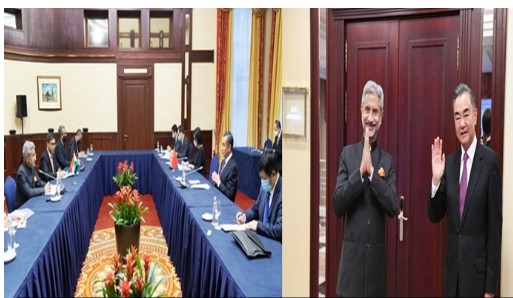
WEB DESK / STAFF REPORTER
India and China have agreed on five points proposal to guide their approach to the situation on the Line of Actual Control (LAC).
In the bilateral meeting between Foreign Minister Dr. S. Jaishankar and his Chinese counterpart Wang Yi held last evening in the sidelines of the SCO Ministerial meet in Moscow, both the Ministers agreed for early disengagement and easing of tensions at the LAC.
The two Foreign Ministers agreed that the current situation in the border areas is not in the interest of either side and the border troops of both sides should continue their dialogue and maintain proper distance.
The two countries also agreed on not allowing differences to become disputes and take cue from the series of consensus between leaders of the two countries on developing India-China relations. In a joint statement released after the bilateral meeting, it has been informed that both the countries agreed to abide by all the existing agreements and protocol on boundary affairs and maintain peace and tranquillity in the border areas. Agreement was also reached to avoid any action that could escalate matters between the two countries. Consensus was arrived at continuing dialogue and communication through the Special Representative Mechanism and the Working Mechanism for Consultation and Coordination on border affairs.
Dr. Jaishankar and Mr. Wang Yi agreed that after the situation eases, the two sides will expedite work to conclude new Confidence Building Measures to maintain and enhance peace and tranquillity in the border areas.
Sources said Dr Jaishankar underlined that since the resumption of Ambassadorial level relations in 1976 and holding of boundary talks since 1981, India-China relations have developed on a largely positive trajectory. While the Indian side recognized that a solution to the boundary question required time and effort, it was also clear that the maintenance of peace and tranquility on the border areas was essential to the forward development of ties. The recent incidents in eastern Ladakh, however, inevitably impacted the development of the bilateral relationship. Therefore, an urgent resolution of the current situation was in the interest of both nations.
Sources also said the Indian side highlighted its strong concern in the meeting at the massing of Chinese troops with equipment along the Line of Actual Control. The presence of such a large concentration of troops was not in accordance with the 1993 and 1996 Agreements and created flash points along the LAC. The Chinese side has not provided a credible explanation for this deployment. The provocative behavior of Chinese frontline troops at numerous incidents of friction along the LAC also showed disregard for bilateral agreements and protocols. The Indian side clearly conveyed that it expected full adherence to all agreements on management of border areas and would not countenance any attempt to change the status quo unilaterally. It was also emphasized that the Indian troops had scrupulously followed all agreements and protocols pertaining to the management of the border areas.
